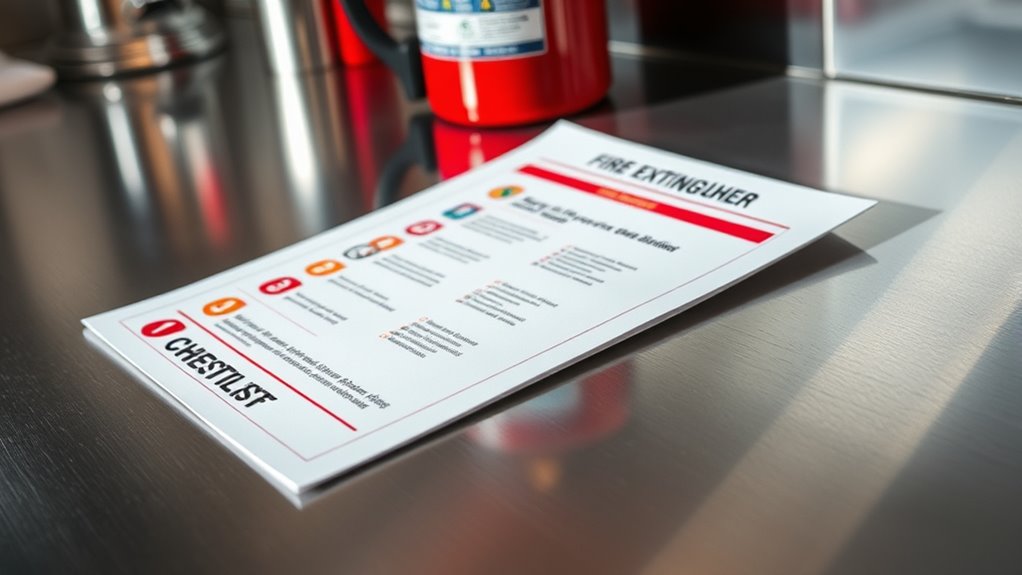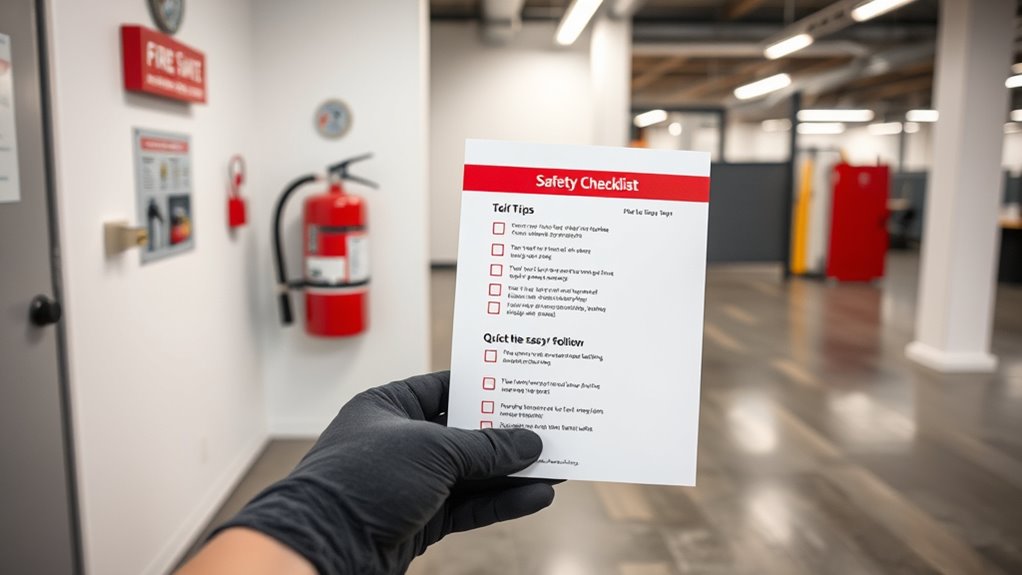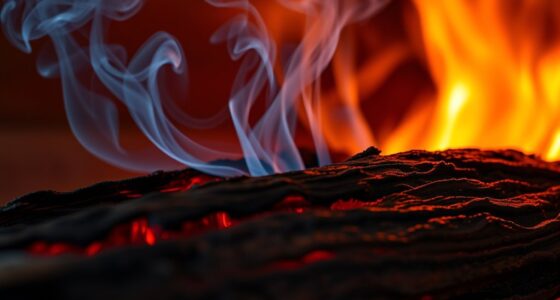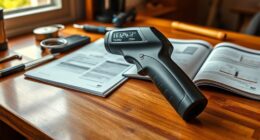To quickly master fire extinguisher basics, start by identifying the right type for different fire classes (A, B, C) and check the label for ratings and compatibility. Regularly inspect your extinguisher: verify the pressure gauge is green, the tamper seal intact, and it’s accessible. Practice using the PASS method—pull, aim, squeeze, sweep—to build confidence. Staying prepared and knowing when to evacuate can make a vital difference; more tips follow if you continue.
Key Takeaways
- Verify extinguisher type and rating to match potential fires in your environment.
- Conduct a quick monthly inspection: check pressure gauge, safety pin, and mounting.
- Practice the PASS technique—Pull, Aim, Squeeze, Sweep—for effective operation.
- Ensure extinguishers are accessible in high-risk areas like kitchen and garage.
- Review fire safety protocols and emergency contacts to stay prepared.
Fire Extinguisher Safety Essentials

Having a fire extinguisher on hand is crucial for safety, but knowing how to use it correctly is equally important. Fire safety isn’t just about having the right equipment; it’s about understanding how to act swiftly and confidently in an emergency. When you’re prepared, you reduce the risk of injury and damage, making your home or workplace a safer environment for everyone. The key to effective emergency preparedness starts with familiarizing yourself with the basics of fire extinguishers and ensuring they’re always ready to use.
Having a fire extinguisher is vital; knowing how to use it confidently ensures safety in emergencies.
First, you need to identify the type of fire extinguisher suitable for different fire classes. Most homes will have a multipurpose extinguisher, typically rated for Class A, B, and C fires—common household fires involving ordinary combustibles, flammable liquids, and electrical equipment. Knowing which extinguisher you have helps you respond more effectively when fire safety becomes a concern. Check the label to confirm its rating, and ensure it’s appropriate for the potential fire hazards in your environment. This small step boosts your confidence and ensures you’re prepared for various scenarios.
Next, perform regular inspections of your fire extinguisher. Make it a habit to check the pressure gauge monthly—ensure the needle is in the green zone. Also, verify that the extinguisher is unobstructed, securely mounted, and that the safety pin and tamper seal are intact. These simple checks prevent surprises during an emergency, allowing you to act swiftly without hesitation. Keep the extinguisher in an accessible location, ideally near the kitchen, garage, or other high-risk areas, so it’s within reach when needed.
Understanding the proper technique to operate a fire extinguisher is essential. Remember the acronym PASS: Pull the pin, Aim the nozzle at the base of the fire, Squeeze the handle, and Sweep from side to side. Practicing this process, perhaps with a fire safety training session or a dry run, can make a big difference when seconds count. It’s important to stay calm, assess the fire’s size, and only attempt to extinguish small fires you can handle safely. If the fire grows or you feel unsure, evacuate immediately and call emergency services.
Additionally, fire extinguisher maintenance is a critical aspect of safety, ensuring your equipment remains functional and reliable over time. Incorporating these basic fire safety practices into your emergency preparedness routine ensures you’re not just relying on equipment but also on your knowledge and confidence. Regularly reviewing and practicing fire extinguisher use can turn a potential disaster into a manageable situation. Being prepared means you’re ready to act swiftly and effectively, protecting yourself, your loved ones, and your property in any fire emergency.
Frequently Asked Questions
How Often Should Fire Extinguishers Be Inspected by Professionals?
You should have fire extinguishers inspected by professionals at least once a year. Regular inspection frequency guarantees they’re in proper working condition and ready when needed. Professional maintenance includes checking pressure, accessibility, and overall condition. If you operate in a high-risk environment, more frequent inspections might be necessary. Keep records of each inspection to stay compliant and ensure your fire safety measures are always up to date.
Can Fire Extinguishers Be Used on Electrical Fires Safely?
You should never use a regular fire extinguisher on electrical fires, as it can pose electrical safety risks. Instead, utilize a Class C fire extinguisher designed specifically for electrical fires, which typically contains non-conductive agents like CO2 or dry chemicals. Always check the fire extinguisher types and ensure you’re using the right one for electrical safety. If unsure, evacuate and call emergency services for professional assistance.
What Are the Common Mistakes to Avoid When Using a Fire Extinguisher?
You might accidentally fall into common misuse or improper handling when using a fire extinguisher, which can make your efforts ineffective or worse. Avoid tilting the extinguisher, aiming at the base of the fire, or rushing. Stay calm, pull the pin, and sweep side to side. Remember, improper handling can delay extinguishing the fire, increasing danger. Stay alert and practice proper technique to protect yourself and others.
How Long Does a Typical Fire Extinguisher Last Before Replacement?
A typical fire extinguisher lasts about 5 to 15 years, depending on its type and usage. You should check its fire extinguisher lifespan regularly and follow the replacement schedule recommended by the manufacturer. Even if it looks fine, don’t delay replacing it after the expiration date, as its effectiveness diminishes over time. Regular inspections guarantee you’re prepared and that your fire safety measures remain reliable.
Are There Different Types of Fire Extinguishers for Specific Fire Classes?
Yes, there are different types of fire extinguishers designed for specific fire classes, ensuring effective firefighting. You should choose fire extinguisher types based on fire class compatibility: Class A for ordinary combustibles, Class B for flammable liquids, Class C for electrical fires, and multi-purpose extinguishers for multiple classes. Always verify the fire extinguisher type to match the potential fire hazards in your environment for ideal safety.
Conclusion
Remember, knowing how to use a fire extinguisher isn’t just a myth—it’s backed by safety experts. Studies show that proper training and quick action can prevent small fires from turning deadly. So, take those 15 minutes to review your extinguisher basics; it could save lives. Don’t believe the myth that firefighting knowledge isn’t essential for everyone. Being prepared and confident truly makes a difference when every second counts.









